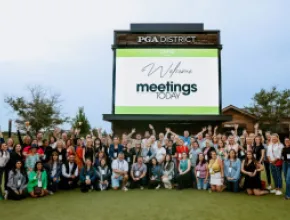HONOLULU--The annual conference of the Asia-Pacific Economic Cooperation (APEC) kicked off Nov. 8 at the Hawaii Convention Center, drawing an extremely high-profile list of attendees from the 21 economies that are members of the organization. The event is said to have a $123 million economic impact on the area.
Guests scheduled to participate in APEC USA 2011 include Chinese President Hu Jintao, Russian President Dmitry Medvedev, Secretary of State Hillary Clinton and President Barack Obama, among other leaders of Asia-Pacific nations. The event will be the largest international event ever held in the state of Hawaii, and according to Hawaiian tourism stakeholders will serve to heighten the destination’s profile as a serious meetings destination both nationally and internationally.
Although attendance figures were not yet available, the event’s historical attendance has hovered around 20,000. Hawaii Convention Center SMG General Manager Joe Davis said that some 4,000 credentials were issued just for those who needed access to the convention center to support the conference.
Lt. Gov. Brian Schatz said the conference will put down a marker to show Hawaii’s prowess at holding such a high-profile, complex event.
“This is important for us because we want the meetings and conventions community to know that we can conduct meetings of this magnitude,” Schatz said.
“I think people are going to find Hawaii, and the Hawaii Visitors and Convention Bureau, can host meetings of this magnitude and do others,” he continued.
Randall Tanaka, SMG assistant general manager of the Hawaii Convention Center and a key organizer of the event, said the successful conclusion of the conference will be a key component of the marketing strategy of both the convention center and the state. A key factor in that strategy, Tanaka said, is that some 40 percent of the world’s economy is evolving out of Asia.
“We’re about convening your business meetings here in Hawaii,” Tanaka said. “What used to be a geographical disadvantage has become a geographical advantage.”
One interesting factor in the room block selection at the conference is that President Obama decided room blocks would be allocated on a free market basis, the first time this has been done at APEC. Some of the more higher-profile nations paid to increase the security at host hotels, such as installing bullet-proof windows and other security measures on the floors they reserved.
According to organizers, Obama also insisted that space be set aside for the inevitable protests that accompany an event of this magnitude.
“Part of this is an exercise to show all of Asia how democracy works,” Tanaka said.
Lt. Gov. Schatz said the state of Hawaii spent between $10 million to $15 million to make general infrastructure improvements for the conference; city and county numbers weren’t available at press time. The funds the state poured into infrastructure improvements are in addition to $47 million that was spent on the airport, which will grow to a $300 million investment beginning next year.
The U.S. State Department is paying for any security improvements needed at the Hawaii Convention Center, along with many other expenses, outside of the room charges paid by participating nations.
Besides showcasing Hawaii’s prowess at holding a high-profile multinational event of this size, Tanaka said the conference will also result in Hawaii tourism stakeholders learning how to more efficiently navigate the often sluggish visa process that can hinder international participation in U.S. meetings.
“What we have learned when we went to Korea [for APEC planning] in the early days is that 95 percent of [visa applicants] were passing through,” he said, adding that much of the challenge of international attendees securing U.S. visas is a function of improving meeting planner and attendee education about the process. “Now that the visa waiver is in place we expect that market to grow. Many attendees don’t know they can get a two-year business visa, so that’s part of the education.”
Mike McCartney, president and CEO of the Hawaii Tourism Authority (HTA), which leads the state’s tourism effort, said the HTA is working with the government to expand the visa process to make it simpler.
“It’s better than yesterday,” he said, “and we’ll keep on working on it.”
Schatz said one big advantage Hawaii had in securing and executing the conference is its highly cooperative business and tourism community, along with a long history of being part of the Asia-Pacific community.
“It’s very key that this APEC is here,” he said. “We know how to interact with the Asia-Pacific community. We’ve been doing it for years.”
John Monahan, president and CEO of the Hawaii Visitors and Convention Bureau, said APEC, and the destination’s ability to navigate its many moving parts, will be key to the state’s strategy of positioning it as a viable business destination, above and beyond its status as an iconic leisure destination.
“How do we use APEC as a platform to build the meetings industry, to understand that it’s not a boondoggle to come to Hawaii?” he asked. “We’re going to use APEC as a platform to show the world that this is a serious meetings destination.”
Hawaii Convention Center General Manager Davis, the person in charge of making sure the main facility is secure and operating as advertised, perhaps summed it up most succinctly.
This week we’re really going through a serious stress test in a way, not only in our operational ability but in our infrastructure,” he said. “APEC is our future.”
The event will end Nov. 13 following a CEO Summit at the Sheraton Waikiki that will include an address by President Obama.
--Tyler Davidson






